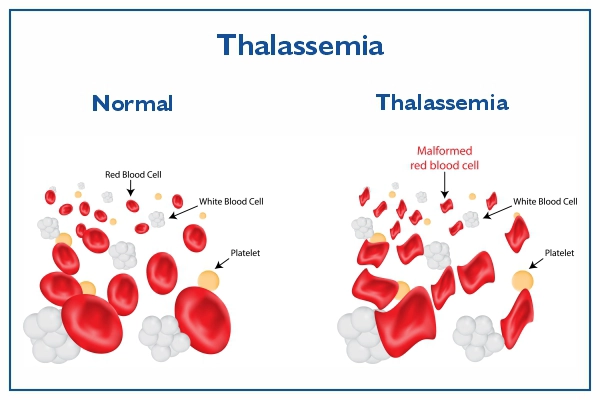Nursing Paper Example on Thalassemia
Nursing Paper Example on Thalassemia
Thalassemia is a hereditary blood disorder characterized by the body’s inability to produce adequate hemoglobin. Hemoglobin is essential for transporting oxygen throughout the body. Individuals with thalassemia inherit defective genes from their parents, resulting in abnormal hemoglobin production, which leads to anemia and other complications. Thalassemia can vary in severity depending on the number and type of gene mutations involved, affecting both treatment and prognosis.

Types of Thalassemia
Thalassemia is primarily categorized into alpha and beta types, based on the specific genes affected.
- Alpha Thalassemia: Caused by mutations in the genes responsible for the alpha globin chain of hemoglobin. There are four genes associated with alpha globin, and the severity of symptoms correlates with the number of affected genes.
- Silent Carrier: One affected gene; generally, no symptoms.
- Alpha Thalassemia Trait: Two affected genes; mild anemia.
- Hemoglobin H Disease: Three affected genes; moderate to severe anemia.
- Alpha Thalassemia Major: All four genes affected; typically results in stillbirth or death shortly after birth due to hydrops fetalis (National Organization for Rare Disorders [NORD], 2023).
- Beta Thalassemia: This type results from mutations in the beta globin genes, of which each individual has two. Severity depends on whether one or both genes are affected.
- Beta Thalassemia Minor: One defective gene, causing mild anemia.
- Beta Thalassemia Intermedia: Intermediate severity, presenting variable symptoms.
- Beta Thalassemia Major (Cooley’s Anemia): Both beta globin genes are mutated, leading to severe anemia and requiring lifelong blood transfusions (Centers for Disease Control and Prevention [CDC], 2022).
Pathophysiology
Thalassemia mutations disrupt the normal production of hemoglobin, resulting in an imbalance between the alpha and beta chains of hemoglobin. In alpha thalassemia, excess beta globin chains form unstable tetramers, damaging red blood cells and reducing their lifespan. In beta thalassemia, unpaired alpha globin chains aggregate, leading to ineffective erythropoiesis (red blood cell production) and hemolysis (destruction of red blood cells). These mechanisms result in chronic anemia and, over time, organ damage due to iron overload from both increased intestinal iron absorption and frequent blood transfusions (Galanello & Origa, 2021).
Signs and Symptoms
The signs and symptoms of thalassemia depend on the type and severity:
- Mild Thalassemia (Minor): Often asymptomatic or shows mild anemia, fatigue, and weakness.
- Moderate to Severe Thalassemia (Intermedia and Major):
- Severe Anemia: Leading to fatigue, pallor, and shortness of breath.
- Jaundice: Caused by red blood cell breakdown.
- Bone Deformities: Particularly in the face and skull due to marrow expansion.
- Splenomegaly: Enlarged spleen due to the excessive breakdown of red blood cells.
- Delayed Growth and Puberty: Resulting from chronic anemia and nutritional deficits.
- Iron Overload: Accumulated iron from transfusions can cause damage to the heart, liver, and endocrine glands (Mayo Clinic, 2023).
Diagnosis
Thalassemia is diagnosed through a combination of blood tests and genetic testing.
- Complete Blood Count (CBC): Reveals the severity of anemia and may show abnormally small and pale red blood cells (microcytic, hypochromic).
- Hemoglobin Electrophoresis: Assesses the types of hemoglobin in the blood, revealing abnormalities characteristic of thalassemia.
- Genetic Testing: Confirms the type of thalassemia by identifying specific mutations.
- Iron Studies: Determine iron levels, as iron deficiency anemia can mimic thalassemia but requires different management (National Heart, Lung, and Blood Institute [NHLBI], 2023).
Treatment Regimens
Treatment for thalassemia varies by type and severity. Common interventions include:
- Blood Transfusions: Regular transfusions increase hemoglobin levels, especially in severe thalassemia, reducing symptoms of anemia.
- Iron Chelation Therapy: Frequent transfusions lead to iron overload. Chelating agents like deferoxamine and deferasirox help remove excess iron.
- Folic Acid Supplements: Supports red blood cell production and alleviates mild anemia symptoms.
- Bone Marrow or Stem Cell Transplantation: The only potential cure for thalassemia, particularly effective in children with severe cases.
- Gene Therapy: Currently in research stages, gene therapy aims to correct the underlying genetic mutation responsible for thalassemia (CDC, 2022).
(Nursing Paper Example on Thalassemia)
Complications
Long-term complications of thalassemia, especially in severe cases, are primarily related to iron overload and chronic anemia:
- Heart Disease: Iron overload can lead to cardiomyopathy, arrhythmias, and heart failure.
- Liver Disease: Excess iron deposits may cause cirrhosis and liver fibrosis.
- Endocrine Disorders: Iron overload disrupts hormone production, leading to diabetes, hypothyroidism, and delayed puberty.
- Osteoporosis: Bone deformities and decreased bone density can increase fracture risk (NORD, 2023).
Prevention and Genetic Counseling
As thalassemia is a genetic condition, genetic counseling is essential for at-risk families, particularly in regions where the condition is more prevalent. Carrier screening and prenatal testing, such as chorionic villus sampling or amniocentesis, can identify carriers and detect affected fetuses, allowing parents to make informed reproductive decisions.
In regions with high prevalence, public health programs promoting awareness and carrier testing help reduce new cases by encouraging informed family planning.
Prognosis
The prognosis for thalassemia depends on the severity and type of the disease, as well as access to adequate healthcare. While beta-thalassemia major requires lifelong management and carries a risk of complications, patients with regular treatment can often achieve improved quality and length of life. Advances in gene therapy may offer new curative possibilities in the future (Mayo Clinic, 2023).
(Nursing Paper Example on Thalassemia)
Conclusion
Thalassemia is a complex, inherited blood disorder with varying degrees of severity. While mild forms may require minimal treatment, severe cases necessitate ongoing medical intervention to manage anemia and prevent complications. Genetic counseling and prenatal testing play key roles in preventing the disease. As research advances, innovative therapies, including gene therapy, offer hope for more effective management and potential cures. Effective diagnosis, monitoring, and treatment are essential for improving patient outcomes, particularly in regions with limited healthcare access.
References
Centers for Disease Control and Prevention (CDC). (2022). Thalassemia. https://www.cdc.gov/ncbddd/thalassemia/facts.html
Galanello, R., & Origa, R. (2021). Beta-thalassemia. Orphanet Journal of Rare Diseases. https://www.ncbi.nlm.nih.gov
Mayo Clinic. (2023). Thalassemia: Symptoms, causes, and treatment. https://www.mayoclinic.org


